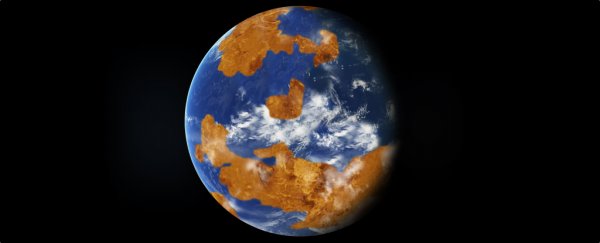Venus is not a nice place, by human standards. For a world named after a Roman goddess of love and beauty, it really is quite the toxic, super-heated hellscape. But it wasn't always this way.
In a new study, scientists make the case for how ancient Venus could have once supported life alongside oceans of liquid water, until a mysterious resurfacing event took all that away about 700 million years ago.
"Our hypothesis is that Venus may have had a stable climate for billions of years," says planetary scientist Michael Way from NASA's Goddard Institute for Space Studies.
"It is possible that the near-global resurfacing event is responsible for its transformation from an Earth-like climate to the hellish hot-house we see today."
The research – presented last week at the EPSC-DPS Joint Meeting 2019 in Geneva, Switzerland – builds upon two previously published studies by Way and his team, and related papers modelling virtualised Venus-like worlds and topographies.
The upshot, the team says, is that 3D GCM (general circulation model) mathematical modelling supports the 'optimistic' view that Venus "spent most of its history with surface liquid water, plate tectonics, and subsequently a stable temperate climate akin to that of Earth through much of its own [history]".
This period of Earth-like climatic stability with liquid water in Venusian oceans may have lasted for up to 3 billion years, the researchers think, based on a number of simulations of what the ancient planet's climate conditions may have been like.
Across a number of hypothetical scenarios run at different points in history – contemplating both deep (310-metre deep) and shallow (10-metre deep) simulated oceans, and a water-world scenario where an imaginary ocean covered all of an 'aquaplanet' Venus – the results suggest ancient Venus could have supported liquid water, with moderate surface temperatures on the planet of 20 to 40 degrees Celsius (68 to 104 Fahrenheit).
At least, this would have been the case as far back as 4.2 billion years ago, right up until about 700 million years ago. Somewhere around that time, something happened on Venus, and ever since the planet has been incredibly hot, with a toxic, heat-trapping 'greenhouse effect' atmosphere dominated by carbon dioxide and nitrogen.
This atmospheric composition is a big part of the reason behind Venus's extraordinarily high temperatures and atmospheric pressure; but how did Earth's 'sister' planet get this way?
"Something happened on Venus where a huge amount of gas was released into the atmosphere and couldn't be re-absorbed by the rocks," Way says.
"On Earth we have some examples of large-scale outgassing, for instance the creation of the Siberian Traps 500 million years ago which is linked to a mass extinction, but nothing on this scale. It completely transformed Venus."
Of course, we can't say for sure that Venus did host life based on the new research. But modelling indicates the planet may have once been conducive to hosting life, based on the potential for liquid water and a moderate, forgiving atmosphere.
We don't know precisely what occurred. In the researchers' version of events, an Earth-like carbonate-silicate cycle (where CO2 is naturally removed from the atmosphere by being absorbed into rocks) got interrupted on Venus, possibly by a period of intense volcanic activity, with magma solidifying on the planet's surface, suspending the cycle, and preventing the gas from being reabsorbed.
If they're right, it not only means Venus could have once supported life, but signifies that planets like Venus – generally considered inhabitable due to close proximity to their host stars – might not be quite as barren after all.
"Our models show that there is a real possibility that Venus could have been habitable and radically different from the Venus we see today," Way says.
"This opens up all kinds of implications for exoplanets found in what is called the 'Venus Zone', which may in fact host liquid water and temperate climates."
The findings were presented at the EPSC-DPS Joint Meeting 2019.
